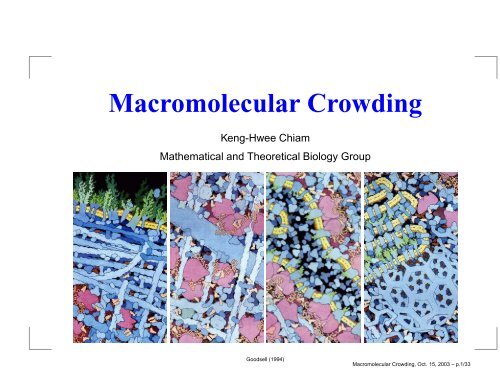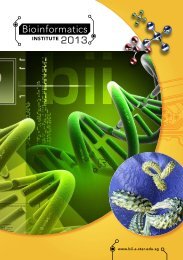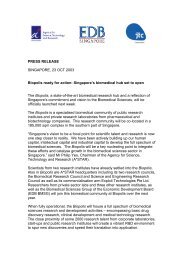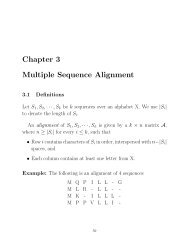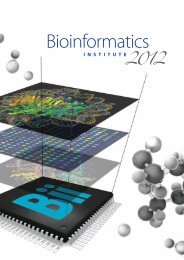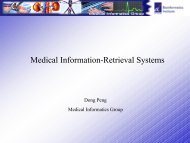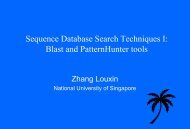Macromolecular Crowding
Macromolecular Crowding
Macromolecular Crowding
You also want an ePaper? Increase the reach of your titles
YUMPU automatically turns print PDFs into web optimized ePapers that Google loves.
<strong>Macromolecular</strong> <strong>Crowding</strong>Keng-Hwee ChiamMathematical and Theoretical Biology GroupGoodsell (1994)<strong>Macromolecular</strong> <strong>Crowding</strong>, Oct. 15, 2003 – p.1/33
OutlineWhat: introduction, definitionWhy: implications on cellular properties and processesHow: quantitative models<strong>Macromolecular</strong> <strong>Crowding</strong>, Oct. 15, 2003 – p.2/33
MotivationBiological media, e.g. cytoplasm:crowded with large moleculesbiophysical, biochemical, physiological propertiesaffectedin vitro assays:neglect non-ideal crowding by, e.g., using dilute solutionsresults cannot be extrapolated to in vivo situation<strong>Macromolecular</strong> <strong>Crowding</strong>, Oct. 15, 2003 – p.3/33
IntroductionCytoplasm packed with RNA, cytoskeletal elements, andother proteins that occupy 5%–40% of volumeD. discoideum, Medalia et al., Science (2002), E. coli, Goodsell (1999)<strong>Macromolecular</strong> <strong>Crowding</strong>, Oct. 15, 2003 – p.4/33
IntroductionRed blood cells packed with hemoglobin, blood serumpacked with antibodies, albumin proteins, etc.Goodsell (1999-2000)<strong>Macromolecular</strong> <strong>Crowding</strong>, Oct. 15, 2003 – p.5/33
DefinitionSum of all macromolecule-macromolecule andmacromolecule-solvent interactionsSteric: repulsion due to excluded volumeHydrodynamic: viscous drag owing to motionChemical: hydrophilic and hydrophobic effectsvan der WaalsElectrostaticNonequilibrium: energy and number fluxes throughmembranesMesoscopic: finite-size effectA messy situation!<strong>Macromolecular</strong> <strong>Crowding</strong>, Oct. 15, 2003 – p.6/33
Steric repulsionPresence of large molecules makes volume less accessible toother large moleculesEllis (2001)Energetically costly to add a large molecule to an alreadycrowded volume<strong>Macromolecular</strong> <strong>Crowding</strong>, Oct. 15, 2003 – p.7/33
Steric repulsionNeglect Coulombic interactions for nowIdeal fluid of point particles: P V = NkTFluid of hard spheres: P (V − b) = NkTExcluded volume b is four times volume of spheres<strong>Macromolecular</strong> <strong>Crowding</strong>, Oct. 15, 2003 – p.8/33
Steric repulsionPresence of n hard spheres leaves (V − nv 0 ) available for(n + 1)-th sphereNumber of microstates and entropy:Ω ∝ V (V − v 0 ) · · · [V − (N − 1)v 0 ]S = k log V + k log(V − v 0 ) + · · · + k log[V − (N − 1)v 0 ]Equation of state:PT = ∂S∂V =NkV − Nv 0 /2 ,v 0 = 4 3 π(2a)3<strong>Macromolecular</strong> <strong>Crowding</strong>, Oct. 15, 2003 – p.9/33
ImplicationsTransport in the cytoplasmKinetics of metabolic channelingEfficiency of protein foldingCellular volume regulationAmyloid fibril formation<strong>Macromolecular</strong> <strong>Crowding</strong>, Oct. 15, 2003 – p.10/33
TransportMechanisms for transport of viruses, gene carriers, etc. in thecytoplasm?Diffusive or ballistic? Passive or active?Important to:Rational design of gene deliveryBioengineering of biocompatible materialsInsights into intracellular reaction-diffusion-typemodeling<strong>Macromolecular</strong> <strong>Crowding</strong>, Oct. 15, 2003 – p.11/33
TransportRate of self-diffusion of proteins lowered as crowdingincreases (Zimmerman and Minton, Annu. Rev. Biophys. Biomol. Struct. 22, 27 (1993)):Replace D∇ 2 c with ⃗ ∇ · [D(c) ⃗ ∇c]<strong>Macromolecular</strong> <strong>Crowding</strong>, Oct. 15, 2003 – p.12/33
TransportHow to obtain efficient transport in lieu of inefficientdiffusion?Active propagation along cytoskeletal elements?Crossover to active propagation as crowding increases2Transport exponent γ = d log 〈r 2 (t)〉 / d log t10 1Volume fraction φReplace ⃗ ∇ · [D(c) ⃗ ∇c] with ⃗ U(⃗x, c) · ⃗∇c + ⃗ ∇ · [D(c) ⃗ ∇c]<strong>Macromolecular</strong> <strong>Crowding</strong>, Oct. 15, 2003 – p.13/33
TransportMeasure local transport properties of cytoplasm, e.g. Wirtz etal. (Biophys. J. 83, 3162 (2002), Biophys. J. 78, 1736 (2000)) and Sackmann etal. (Biophys. J. 76, 573 (1999), Biophys. J. 75, 2038 (1998))<strong>Macromolecular</strong> <strong>Crowding</strong>, Oct. 15, 2003 – p.14/33
TransportInject tracers (e.g., fluorescent µspheres) into cytoplasmBrownian motion with dissipation depending on earliervelocities:m ˙v(t) = −∫ t0ζ(t − τ)v(τ)dτ + f R (t)where ζ(t) is memory functionIn thermal equilibrium, noise correlation:〈f R (0)f R (t)〉 = k B T ζ(t)Obtain velocity correlation in terms of measurable meansquare displacement 〈∆r 2 (t)〉<strong>Macromolecular</strong> <strong>Crowding</strong>, Oct. 15, 2003 – p.15/33
TransportSusceptibility:G(s) =k B Tπas〈∆r 2 (s)〉Real part G ′ (ω) is storage modulus, imaginary part G ′′ (ω) isloss modulusIn a fluid, 〈∆r 2 (t)〉 = 6Dt with D = k B T/6πηa:G ′ (ω) = 0,G ′′ (ω) = ηωIn a solid, 〈∆r 2 (t)〉 independent of t:G ′ (ω) = const., G ′′ (ω) = 0<strong>Macromolecular</strong> <strong>Crowding</strong>, Oct. 15, 2003 – p.16/33
TransportCytoplasm has non-zero G ′ (ω) and non-zero G ′′ (ω)Stiff Hookean solid at high deformation ratesSoft viscous liquid at low deformation ratesViscoelasticity arises from elastic macromolecules in viscousliquidReplace diffusion in reaction-diffusion models with ???<strong>Macromolecular</strong> <strong>Crowding</strong>, Oct. 15, 2003 – p.17/33
Metabolic channelingHow does crowding affect fluxes through signal transductionpathways?Posphoenolpyruvate:carbohydrate phosphotransferase system(PTS):Uptake and phosphorylation of carbohydratesPhosphoryl group transferred sequentially along a seriesof proteins to carbohydrate molecule<strong>Macromolecular</strong> <strong>Crowding</strong>, Oct. 15, 2003 – p.18/33
Metabolic channelingRohwer, Westerhoff et al. (P. Natl. Acad. Sci. USA 95, 10547 (1998))measured steady-state flux through PTS in vitroFlux ∝ concentration 2 :low concentrationperfect channel, “hit and run”Flux ∝ concentration:high concentration and/or with crowdingenzymes exist as complexes<strong>Macromolecular</strong> <strong>Crowding</strong>, Oct. 15, 2003 – p.19/33
Metabolic channelingTotal flux and flux-response coefficient vs. total enzymeconcentration:<strong>Macromolecular</strong> <strong>Crowding</strong>, Oct. 15, 2003 – p.20/33
Metabolic channelingTwo-enzyme group-transfer model:<strong>Crowding</strong> added in as changes to association/disassociationrates<strong>Macromolecular</strong> <strong>Crowding</strong>, Oct. 15, 2003 – p.21/33
Efficiency of protein foldingProteins fold in central cage of GroEL/GroES chaperoninMartin and Hartl (P. Natl. Acad. Sci. USA 94, 1107 (1997)) showed:crowding helps retain nonnative polypeptide<strong>Macromolecular</strong> <strong>Crowding</strong>, Oct. 15, 2003 – p.22/33
Cellular volume regulationHow do cells detect changes in their volume?Minton et al. (P. Natl. Acad. Sci. USA 89, 10504 (1992)) proposed thatduring swelling:cellular interior less crowdedinhibits kinase relative to phosphatase activityincreases concentration of transporter<strong>Macromolecular</strong> <strong>Crowding</strong>, Oct. 15, 2003 – p.23/33
Amyloid fibril formationNeurodegenerative diseases, e.g., Parkinson’s disease,characterized by amyloid fibril formationShtilerman et al. (Biochemistry 41, 3855 (2002)) showed that crowdingreduced lag time for protofibril formation and conversion ofprotofibril to fibril<strong>Macromolecular</strong> <strong>Crowding</strong>, Oct. 15, 2003 – p.24/33
Quantitative modelsHard spheres fluid, amenable to theoryAtomic-level models using molecular dynamicsContinuum models<strong>Macromolecular</strong> <strong>Crowding</strong>, Oct. 15, 2003 – p.25/33
Hard spheres fluidToy model: Spheres with hard core potential{∞ r < au(r) =0 r ≥ ain vacuumTwo parameters: radius of spheres a, and volume fraction φCalculate thermodynamic and kinetic properties in (a, φ)phase space using:tabulated virial coefficients (Hall and Minton, Biochim. Biophys. Acta1649, 127 (2003))Monte Carlo simulations<strong>Macromolecular</strong> <strong>Crowding</strong>, Oct. 15, 2003 – p.26/33
Hard spheres fluidConsider effects on equilibrium of dimerizationA + A ⇌ A 2Calculate non-ideal contribution to K vs. volume fraction φ(Hall and Minton, Biochim. Biophys. Acta 1649, 127 (2003))<strong>Macromolecular</strong> <strong>Crowding</strong>, Oct. 15, 2003 – p.27/33
Hard spheres fluidIn addition to hard spheres, to study transport:Mimic actin elements by stationary rodsModel binding and transport on these rods<strong>Macromolecular</strong> <strong>Crowding</strong>, Oct. 15, 2003 – p.28/33
Atomic-level modelsElcock (P. Natl. Acad. Sci. USA 100, 2340 (2003)) modeled escape ofrhodanese from cavity of GroEL into crowded solvent<strong>Macromolecular</strong> <strong>Crowding</strong>, Oct. 15, 2003 – p.29/33
Atomic-level modelsUses known GroEL conformationOmits GroESModels crowding agent as spheresIncorporates repulsive r −12 interaction between spheres andrhodaneseUses Brownian motion for crowder spheresAssumes periodic boundariesContains 64000 atoms<strong>Macromolecular</strong> <strong>Crowding</strong>, Oct. 15, 2003 – p.30/33
Atomic-level models<strong>Crowding</strong> enhances efficiency of chaperonins GroEL andGroES:Enhances association of GroEL and GroES, preventingescape<strong>Macromolecular</strong> <strong>Crowding</strong>, Oct. 15, 2003 – p.31/33
Atomic-level modelsFriedel et al. (J. Chem. Phys. 118, 8106 (2003)) simulated a version ofthe 46 residue off-lattice minimalist model using moleculardynamicsRestricts protein to sphere with soft well repulsive potential<strong>Crowding</strong> decreases folding time<strong>Macromolecular</strong> <strong>Crowding</strong>, Oct. 15, 2003 – p.32/33
Conclusions<strong>Macromolecular</strong> crowding has important biophysical,biochemical, and physiological implications on intracellularprocessesInteresting problems:Spatial dependence of transport in cytoplasm fromincreasing accurate modelingUnderstanding role of crowding in kinetics of metabolicchanneling<strong>Macromolecular</strong> <strong>Crowding</strong>, Oct. 15, 2003 – p.33/33


